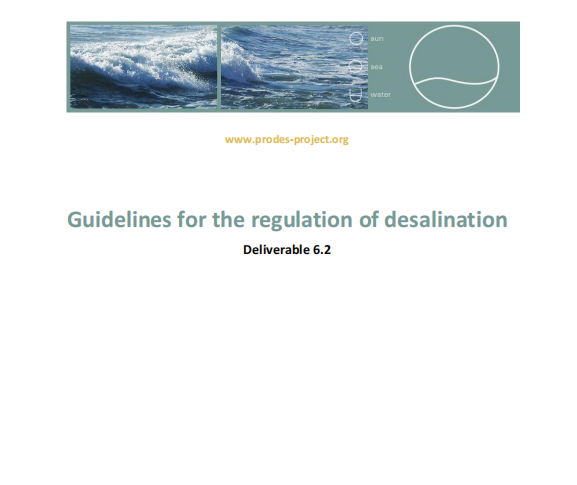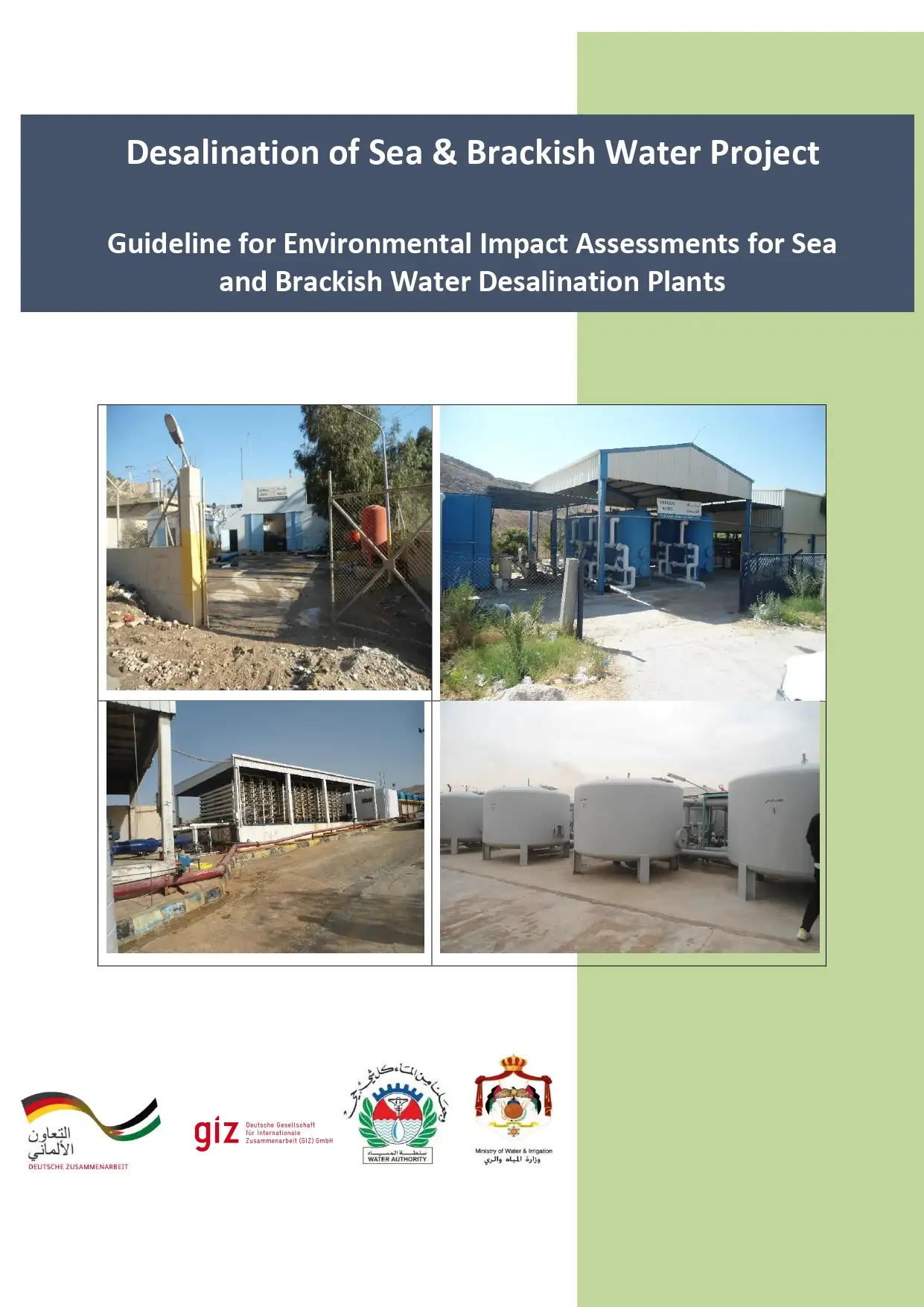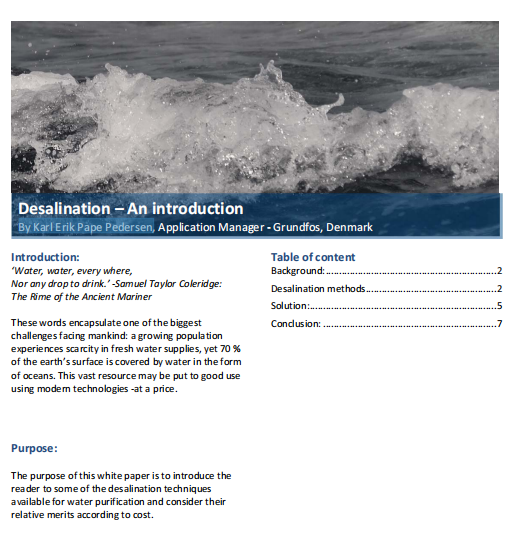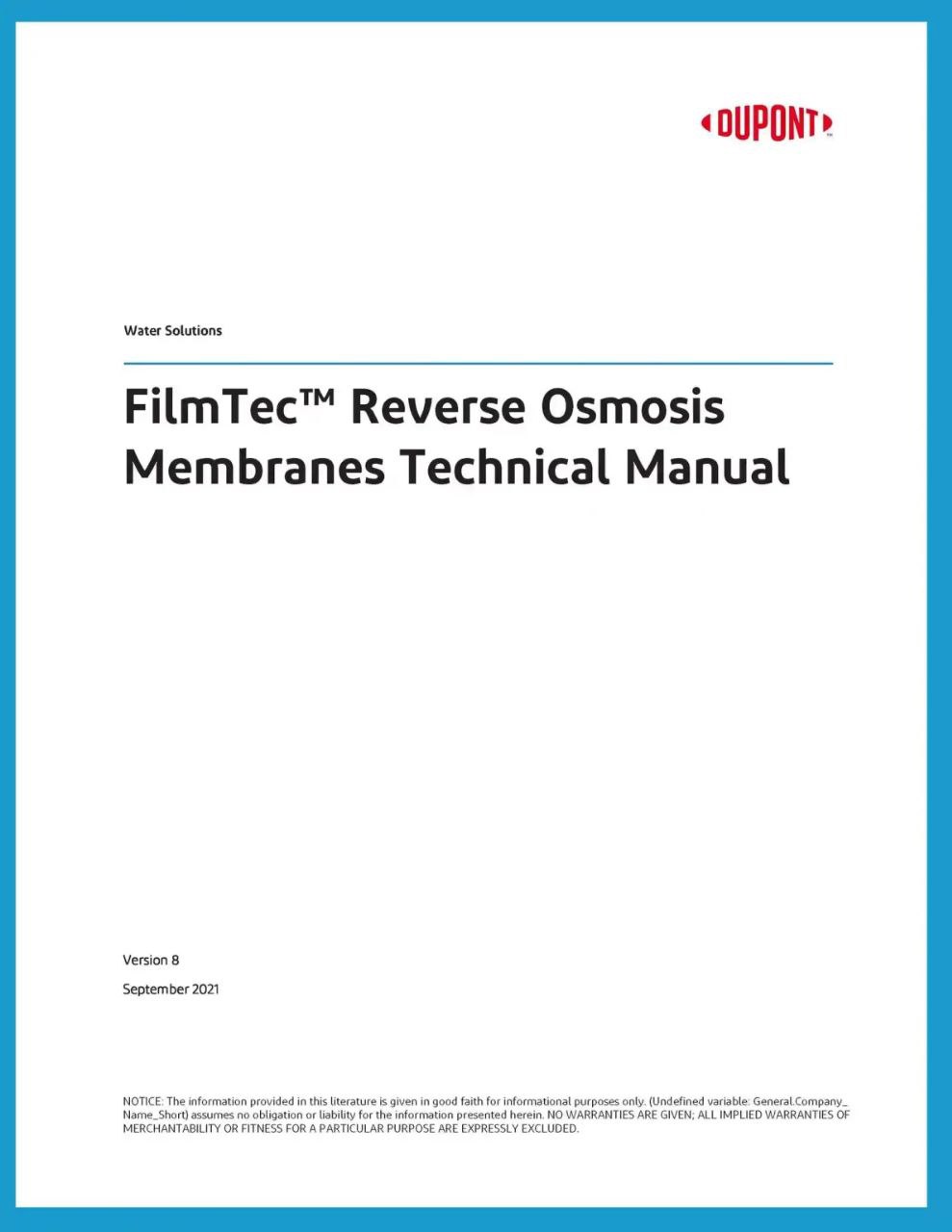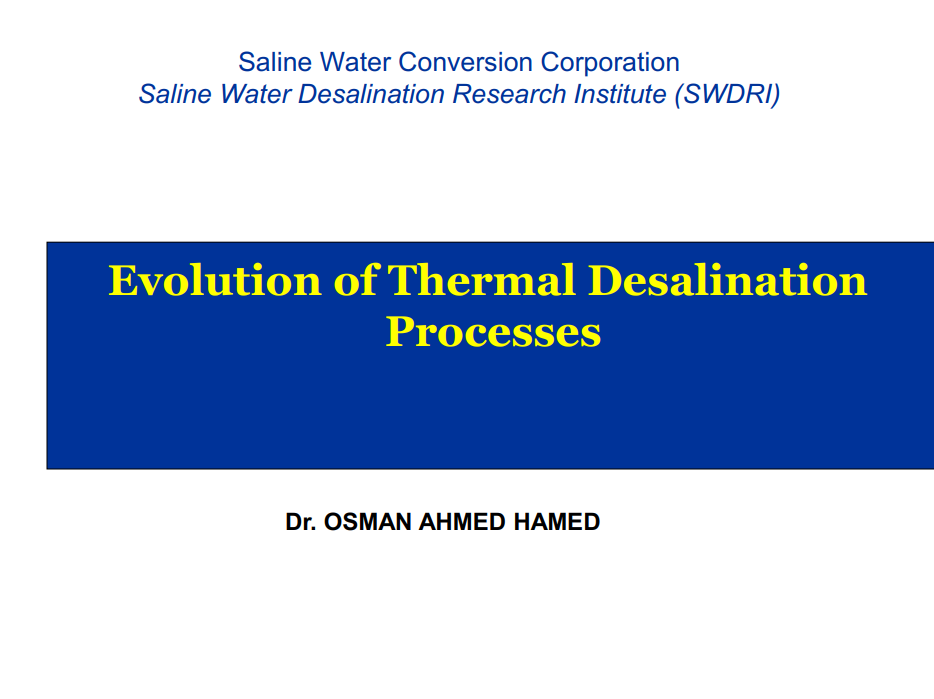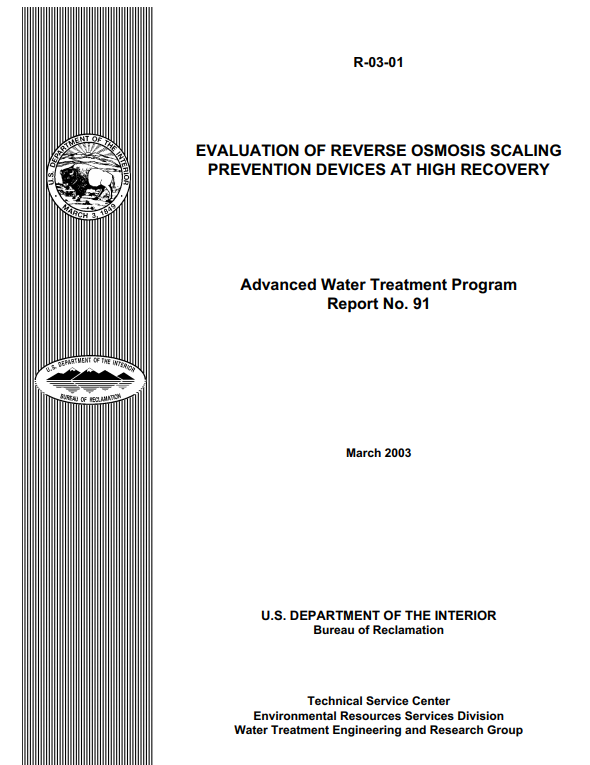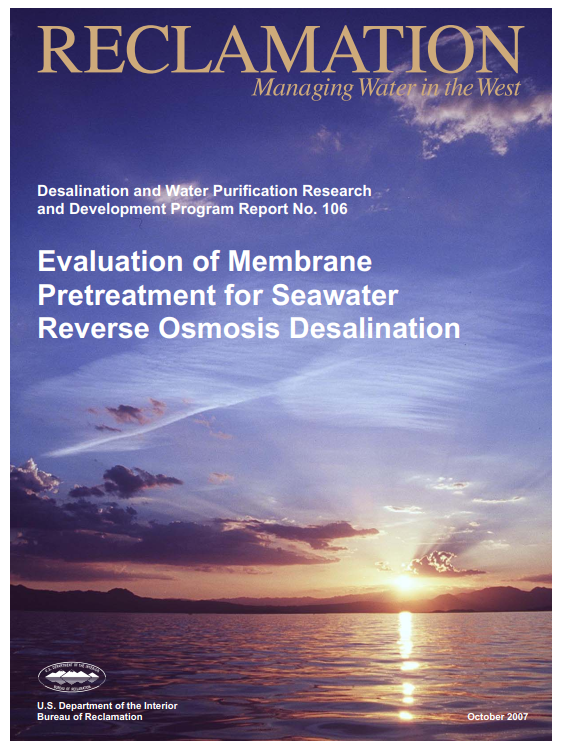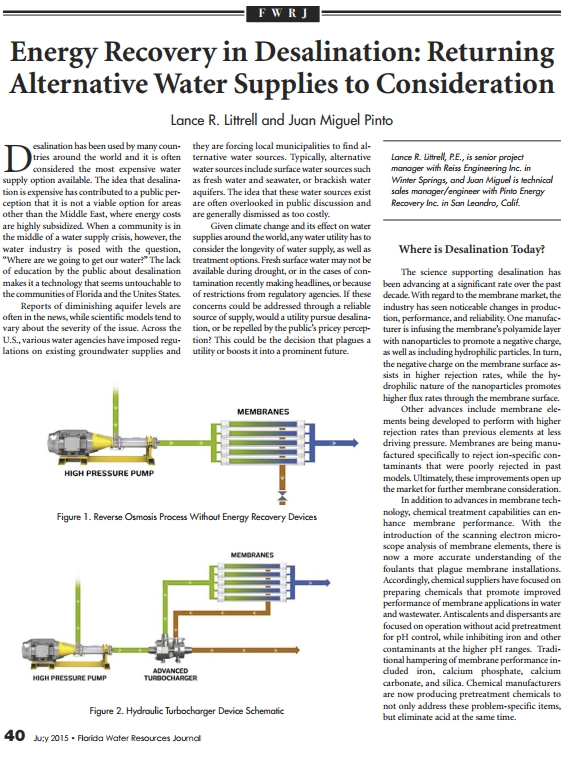Guidelines For The Regulation Of Desalination
Introduction
This report aims to develop guidelines for legislation addressing drinking water quality and environmental protection aspects related to desalination driven by renewable energy (RE‐ Desalination). At the same time ways to remove some of the barriers RE‐Desalination is facing are recommended in order to assist a deployment of these facilities for an improved access to safe and sustainable drinking water in regions of water scarcity.
The report has been developed within the ProDes project which is promoting the market development of desalination driven by renewable energies in Southern Europe. ProDes is co‐funded by the European Commission through the Intelligent Energy Programme and has been supporting RE‐Desalination through various activities like training for professionals and students, seminars and technical publications. Extensive information about ProDes, the partners and the results is published on the project website: www.prodes‐project.org.
The report includes an overview of currently existing guidance on desalination driven by renewable energies followed by an analysis of health, environmental and administrative aspects critical for the development of guidelines. General recommendations of elements to be included in guidelines are developed from a literature analysis. To what extent these qualify for application in various circumstances should be tested in additional country‐specific studies
Guidelines For The Regulation Of Desalination
Introduction
This report aims to develop guidelines for legislation addressing drinking water quality and environmental protection aspects related to desalination driven by renewable energy (RE‐ Desalination). At the same time ways to remove some of the barriers RE‐Desalination is facing are recommended in order to assist a deployment of these facilities for an improved access to safe and sustainable drinking water in regions of water scarcity.
The report has been developed within the ProDes project which is promoting the market development of desalination driven by renewable energies in Southern Europe. ProDes is co‐funded by the European Commission through the Intelligent Energy Programme and has been supporting RE‐Desalination through various activities like training for professionals and students, seminars and technical publications. Extensive information about ProDes, the partners and the results is published on the project website: www.prodes‐project.org.
The report includes an overview of currently existing guidance on desalination driven by renewable energies followed by an analysis of health, environmental and administrative aspects critical for the development of guidelines. General recommendations of elements to be included in guidelines are developed from a literature analysis. To what extent these qualify for application in various circumstances should be tested in additional country‐specific studies
Desalination of Sea & Brackish Water Project
Introduction:
Desalination projects require an Environmental and Social Impact Assessment (ESIA) study to determine the potential impacts a project can have on the environment. The “ESIA” considers all environmental pathways. It evaluates the potential impacts on air, land, and marine environments and proposes mitigation measures to reduce environmental impacts. The potential impacts of desalination plants are different from the environmental impacts of other facilities. In particular, the brine discharge from desalination plants can have huge impacts. Therefore, it is proposed by this document to follow a dedicated routine in the ESIA process for brackish and seawater desalination plants. An “ESIA” needs to cover the following stages of a project which are: the construction; the operation, and the decommissioning stages. During the construction stage, the construction process can be time-consuming, inconvenient, loud, destructive, and disruptive to the environment. It is ideal to have as little impact from the construction as necessary. If used water resources, connections to services, and water infrastructure are near the proposed plant site, then there will be fewer constructional interventions required and thus less potential environmental damages would occur. When construction begins, the party responsible for follow-up on the ESIA needs to monitor according to the Environmental Management Plan issues identified in the ESIA so that the agreed plan is implemented and followed. For the operation stage, the “ESIA” report discusses the chosen desalination process, the emissions process will generate, the implications the facility will have on the environment, the considerations to be made about the energy supply, the benefits the facility will have on the local community from a socio-economic perspective, and the proposed mitigation measures to reduce problems associated with the facility. It is even more important to monitor all aspects addressed in the ESIA’s Environmental Management Plans (EMP) during the operational stage to ensure consistent compliance with agreed permittable environmental impacts
Desalination of Sea & Brackish Water Project
Introduction:
Desalination projects require an Environmental and Social Impact Assessment (ESIA) study to determine the potential impacts a project can have on the environment. The “ESIA” considers all environmental pathways. It evaluates the potential impacts on air, land, and marine environments and proposes mitigation measures to reduce environmental impacts. The potential impacts of desalination plants are different from the environmental impacts of other facilities. In particular, the brine discharge from desalination plants can have huge impacts. Therefore, it is proposed by this document to follow a dedicated routine in the ESIA process for brackish and seawater desalination plants. An “ESIA” needs to cover the following stages of a project which are: the construction; the operation, and the decommissioning stages. During the construction stage, the construction process can be time-consuming, inconvenient, loud, destructive, and disruptive to the environment. It is ideal to have as little impact from the construction as necessary. If used water resources, connections to services, and water infrastructure are near the proposed plant site, then there will be fewer constructional interventions required and thus less potential environmental damages would occur. When construction begins, the party responsible for follow-up on the ESIA needs to monitor according to the Environmental Management Plan issues identified in the ESIA so that the agreed plan is implemented and followed. For the operation stage, the “ESIA” report discusses the chosen desalination process, the emissions process will generate, the implications the facility will have on the environment, the considerations to be made about the energy supply, the benefits the facility will have on the local community from a socio-economic perspective, and the proposed mitigation measures to reduce problems associated with the facility. It is even more important to monitor all aspects addressed in the ESIA’s Environmental Management Plans (EMP) during the operational stage to ensure consistent compliance with agreed permittable environmental impacts
Desalination – An introduction
Introduction:
Water, water, every where, Nor any drop to drink.’ ‐Samuel Taylor Coleridge: The Rime of the Ancient Mariner These words encapsulate one of the biggest challenges facing mankind: a growing population experiences scarcity in fresh water supplies, yet 70 % of the earth’s surface is covered by water in the form of oceans. This vast resource may be put to good use using modern technologies ‐at a price.
Desalination – An introduction
Introduction:
Water, water, every where, Nor any drop to drink.’ ‐Samuel Taylor Coleridge: The Rime of the Ancient Mariner These words encapsulate one of the biggest challenges facing mankind: a growing population experiences scarcity in fresh water supplies, yet 70 % of the earth’s surface is covered by water in the form of oceans. This vast resource may be put to good use using modern technologies ‐at a price.
Forward Osmosis
Abstract:
Fresh, potable water is an essential human need and thus looming water shortages threaten the world’s peace and prosperity. Waste water, brackish water, and seawater have great potential to fill the coming requirements. Unfortunately, the ability to exploit these resources is currently limited in many parts of the world by both the cost of the energy and the investment in equipment required for purification/desalination. Current research suggests that forward osmosis is a novel, low-energy, and thus low cost method of desalination and developing practical draw solutions can improve the efficiency of this process.
To address these limitations, this study focuses on forward osmosis technology, its effective operational conditions chosen wisely based on the membrane to be used and the streams to be treated and providing a feasible economic estimation
Forward Osmosis
Abstract:
Fresh, potable water is an essential human need and thus looming water shortages threaten the world’s peace and prosperity. Waste water, brackish water, and seawater have great potential to fill the coming requirements. Unfortunately, the ability to exploit these resources is currently limited in many parts of the world by both the cost of the energy and the investment in equipment required for purification/desalination. Current research suggests that forward osmosis is a novel, low-energy, and thus low cost method of desalination and developing practical draw solutions can improve the efficiency of this process.
To address these limitations, this study focuses on forward osmosis technology, its effective operational conditions chosen wisely based on the membrane to be used and the streams to be treated and providing a feasible economic estimation
Reverse Osmosis Membranes Technical Manual
Introduction:
To increase the efficiency and life of reverse osmosis and nanofiltration (RO/NF) systems, effective pretreatment of the feedwater is required. Selection of the proper pretreatment will maximize efficiency and membrane life by minimizing:
- Fouling
- Scaling
- Membrane degradation
Reverse Osmosis Membranes Technical Manual
Introduction:
To increase the efficiency and life of reverse osmosis and nanofiltration (RO/NF) systems, effective pretreatment of the feedwater is required. Selection of the proper pretreatment will maximize efficiency and membrane life by minimizing:
- Fouling
- Scaling
- Membrane degradation
Evaluation Of Reverse Osmosis Scaling Prevention Devices At High Recovery
Abstract:
This study evaluated the effectiveness of a magnetic device (MD) and a high voltage capacitance device (HVC) as possible alternatives to the dosing of chemical antiscalants for preventing scaling during reverse osmosis (RO) operation at high product water recovery. The tests were conducted on feed water to the Bureau of Reclamation’s 72-MGD Yuma Desalting Plant located in Yuma AZ. High overall recoveries of greater than 90 percent were achieved by operating a two-stage 4-gal/min RO pilot unit (membrane unit 1 [MU1]) on the concentrate from a 200-gal/min RO unit operating at a water recovery of 70-percent. In these tests, neither the MD nor the HVC were effective in preventing calcium sulfate scaling at 91-percent water recovery. In contrast, the addition of 2 mg/L of sodium hexametaphosphate (SHMP) to MU1 feed water was successful in avoiding scale at recoveries of 93 percent. Dosing of SHMP (or other chemical antiscalant) remains the recommended method for achieving high recovery operation without scaling at the Yuma Desalting Plant.
Evaluation Of Reverse Osmosis Scaling Prevention Devices At High Recovery
Abstract:
This study evaluated the effectiveness of a magnetic device (MD) and a high voltage capacitance device (HVC) as possible alternatives to the dosing of chemical antiscalants for preventing scaling during reverse osmosis (RO) operation at high product water recovery. The tests were conducted on feed water to the Bureau of Reclamation’s 72-MGD Yuma Desalting Plant located in Yuma AZ. High overall recoveries of greater than 90 percent were achieved by operating a two-stage 4-gal/min RO pilot unit (membrane unit 1 [MU1]) on the concentrate from a 200-gal/min RO unit operating at a water recovery of 70-percent. In these tests, neither the MD nor the HVC were effective in preventing calcium sulfate scaling at 91-percent water recovery. In contrast, the addition of 2 mg/L of sodium hexametaphosphate (SHMP) to MU1 feed water was successful in avoiding scale at recoveries of 93 percent. Dosing of SHMP (or other chemical antiscalant) remains the recommended method for achieving high recovery operation without scaling at the Yuma Desalting Plant.
Evaluation of Membrane Pretreatment for Seawater Reverse Osmosis Desalination
Abstract:
This project was undertaken to better understand the technical and cost implications of the use of membrane filtration as pretreatment for seawater reverse osmosis (RO). The pilot study was conducted using raw feed water from the Corpus Christi Bay in Texas, at the San Patricio Municipal Water District facility. The pilot study consisted of a side-by-side comparison of membrane filtration and conventional filtration, both followed by separate RO pilot systems, testing over an approximate 1-year period. The results indicate that membrane filtration produced far superior water quality for pretreatment, measured by reduced turbidity and by the silt density index (SDI). The resulting impact on the RO performance was a significantly lower RO cleaning frequency. The economic evaluation indicates that on a life-cycle cost analysis, the total water cost (TWC) for a plant using membrane filtration is 4-8% less than a plant using media filtration.
Evaluation of Membrane Pretreatment for Seawater Reverse Osmosis Desalination
Abstract:
This project was undertaken to better understand the technical and cost implications of the use of membrane filtration as pretreatment for seawater reverse osmosis (RO). The pilot study was conducted using raw feed water from the Corpus Christi Bay in Texas, at the San Patricio Municipal Water District facility. The pilot study consisted of a side-by-side comparison of membrane filtration and conventional filtration, both followed by separate RO pilot systems, testing over an approximate 1-year period. The results indicate that membrane filtration produced far superior water quality for pretreatment, measured by reduced turbidity and by the silt density index (SDI). The resulting impact on the RO performance was a significantly lower RO cleaning frequency. The economic evaluation indicates that on a life-cycle cost analysis, the total water cost (TWC) for a plant using membrane filtration is 4-8% less than a plant using media filtration.
Energy Recovery in Desalination: Returning Alternative Water Supplies to Consideration
Abstract:
Desalination has been used by many countries around the world and it is often considered the most expensive water supply option available. The idea that desalination is expensive has contributed to a public perception that it is not a viable option for areas other than the Middle East, where energy costs are highly subsidized. When a community is in the middle of a water supply crisis, however, the water industry is posed with the question, “Where are we going to get our water?” The lack of education by the public about desalination makes it a technology that seems untouchable to the communities of Florida and the Unites States. Reports of diminishing aquifer levels are often in the news, while scientific models tend to vary about the severity of the issue. Across the U.S., various water agencies have imposed regulations on existing groundwater supplies and they are forcing local municipalities to find alternative water sources. Typically, alternative water sources include surface water sources such as fresh water and seawater, or brackish water aquifers. The idea that these water sources exist are often overlooked in public discussion and are generally dismissed as too costly. Given climate change and its effect on water supplies around the world, any water utility has to consider the longevity of water supply, as well as treatment options.
Energy Recovery in Desalination: Returning Alternative Water Supplies to Consideration
Abstract:
Desalination has been used by many countries around the world and it is often considered the most expensive water supply option available. The idea that desalination is expensive has contributed to a public perception that it is not a viable option for areas other than the Middle East, where energy costs are highly subsidized. When a community is in the middle of a water supply crisis, however, the water industry is posed with the question, “Where are we going to get our water?” The lack of education by the public about desalination makes it a technology that seems untouchable to the communities of Florida and the Unites States. Reports of diminishing aquifer levels are often in the news, while scientific models tend to vary about the severity of the issue. Across the U.S., various water agencies have imposed regulations on existing groundwater supplies and they are forcing local municipalities to find alternative water sources. Typically, alternative water sources include surface water sources such as fresh water and seawater, or brackish water aquifers. The idea that these water sources exist are often overlooked in public discussion and are generally dismissed as too costly. Given climate change and its effect on water supplies around the world, any water utility has to consider the longevity of water supply, as well as treatment options.


